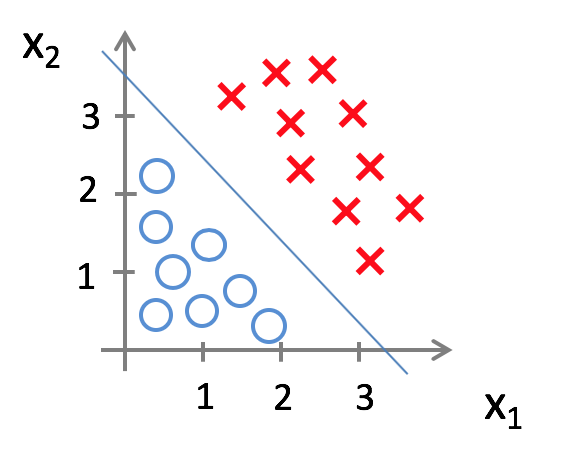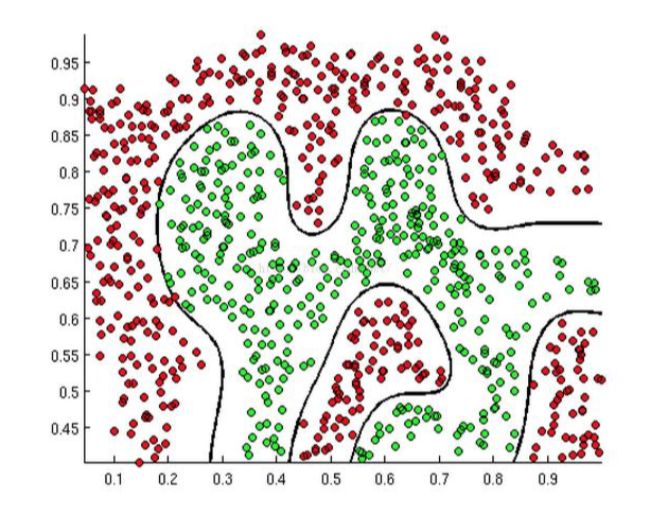【Logistic回归】
-
简介
Logistic回归(也称逻辑回归),是最常用的一种二分类算法。回归,一词多用来进行数据拟合,进而预测连续型数据。Logistic回归,是一种对数据进行分类的算法(也可以说是对数据进行预测,只不过预测y是离散型数据),之所以称为回归是由历史原因所决定的,在此不用过多的深究。最后再强调一次:Logistic回归是最经典、最常用的二分类算法。
逻辑回归属于二元分类问题,我们将因变量y的值域限定为{0,1},其中0代表负向类(negative class),1代表正向类(positive class),相比于线性回归,线性回归因变量y是连续值,随着样本的不同,其变化范围可能严重超出(0,1)区间。
注意: 在这里要区分y和的区别,对于线性回归
其中表示实际值与预测值之间的误差,在忽略误差的情况下。
对于逻辑回归,
而是
即:if ,则; if ,则
所以严格限制在(0,1)区间内,即
总结: Logistic回归和线性回归都用来对数据进行预测,只不过Logistic回归的取值范围为离散型有限集合,例如:,而线性回归的取值范围为连续型集合,的取值区间是不可控的。特别对于二元分类,Logistic回归, -
假说表示
为了找到合适的模型,使得,我们假设逻辑回归模型为:
其中,X代表特征向量,g代表逻辑函数(logistic function),g(z)也称作sigmod函数,
sigmod函数的图像如下图所示:
我们发现该函数特点明显,Z>0就接近1,Z<0就接近0,Z=0,g(z)=0.5
解释: 将的取值限制在(0,1)区间,是将值得问题转换为概率问题,也就是分类问题。即:h?(?)的作用是,对于给定的输入变量,根据选择的参数计算输出变量(y)=1 的可能性(estimated probablity),即
例如,如果对于给定的?,通过已经确定的参数计算得出:则表示有 70%的几率?为正向类,相应地?为负向类的几率为 1-0.7=0.3。
总结: 逻辑回归假设函数是将线性回归中得到的预测值,作为参数,传递给sigmod函数,完成由值到概率的转换,进而实现分类。 -
决策边界
决策边界,是用来进行类别划分的边界函数。可以是线性函数也可以是非线性函数。具体表现如下图所示:
线性边界函数,如上图中的蓝色直线,其
线性边界函数,如上图中的黑色曲线,其
解释 在逻辑回归中,我们预测:- 当时,
- 当时,
由于假设函数为:
由,可得,进而
,可得,进而
故逻辑回归的决策边界函数的确定,可以通过一下公式来确定:
而其中,无论是一阶线性函数(直线边界),函数带有高阶项的非线性函数(曲线边界)。因为无论是高阶还是低阶,我们都可以当做线性回归来处理。 -
代价函数(损失函数)
对于逻辑回归,我们也可以采用线性回归的方式来构建损失函数,即:代价函数是所有模型误差的平方和 ,但是我们将带入其中,发现得到的代价函数是一个非凸函数,存在许多局部最小解,这种函数对于梯度下降算法来说是不可行的。其中线性回归的代价函数为:
-
以下是吴恩达给出的思路:
重新定义逻辑回归的代价函数为:
其中
对应的的变化趋势如下所示:
当实际,且时,Cost函数为0,即误差为0;
当实际,而时,误差随着变小而变大。
当实际,且时,Cost函数为0,即误差为0;
当实际,而时,误差随着变大而变大。
将合并成一个式子如下:
带入代价函数得到:
即:
虽然这个公式从这个角度来解释很合理,但由于没有详细的推导过程总是感觉十分突兀。 -
我认为更合理的推导思路:从概率的角度分析问题
预测函数:
对于分类任务:
整合可得:
似然函数:求在未知参数的情况下,整体样本出现的概率最大。
对数似然:
损失函数是一个用来衡量数据拟合程度的函数,通过求损失函数的最小值,来确定参数。对于对数似然,越大,拟合的就越好,于是问题变成了求最大值的问题,为了,采用梯度下降的算法,我们引入
将梯度上升转换为梯度下降。故损失函数为:
通过对比发现,这两种解释得到的最终的结果都是一样的。 -
梯度下降算法理论推导
根据线性回归的相关知识,我们知道梯度下降算法为:
所以对求偏导如下:
故梯度下降算法的最终迭代过程为:
代码实现:
#数据采用:链接: https://pan.baidu.com/s/1gtXlB9E2E5XbnwswG2banQ 提取码: 5zju
import numpy as np
import pandas as pd
import matplotlib.pyplot as plt
import numpy.random
import time
#定义了三种停止梯度下降循环的方式
STOP_ITER=0
STOP_COST=1
STOP_GRAD=2
def readData(path):
#读取数据
data =pd.read_csv(path,header=None,names=['Exam1','Exam2','Admitted'])
#加工数据:在每一个样本的开始添加一个1字段
data.insert(0,'One',1)
return data
#sigmoid函数,将数值转换为0~1之间的概率
def sigmoid(z):
return 1/(1+np.exp(-z))
#定义预测函数hθ(x),也即我们的预测函数
def model(X,theta):
return sigmoid(np.dot(X,theta.T))
#损失函数的定义
def cost(X,Y,theta):
left =np.multiply(-Y,np.log(model(X,theta)))
right = np.multiply(1 - Y, np.log(1 - model(X, theta)))
return np.sum(left-right)/len(X)
#计算梯度,相当于一次梯度下降循环
def gradient(X, Y, theta):
grad = np.zeros(theta.shape)
error = (model(X, theta)- Y).ravel()
for j in range(len(theta.ravel())): #for each parmeter
term = np.multiply(error, X[:,j])
grad[0, j] = np.sum(term) / len(X)
return grad
#对数据进行洗牌,避免由于人工搜集数据导致的数据分布不随机,增加数据的一般性
def shuffleData(data):
np.random.shuffle(data)
cols = orig_data.shape[1]
X = data[:,0:cols-1]
Y = data[:,cols-1:]
return X,Y
#设定三种不同的停止策略
def stopCriterion(type,value,threshold):
if type ==STOP_ITER: return value>threshold
elif type ==STOP_COST: return abs(value[-1]-value[-2])<threshold
elif type ==STOP_GRAD: return np.linalg.norm(value)<threshold
#梯度下降函数
def descent(data,theta,batchSize,stopType,thresh,alpha):
#梯度下降求解
#初始化时间
init_time =time.time()
i =0#迭代次数
k =0 #batch
X,Y=shuffleData(data)
grad =np.zeros(theta.shape)
costs =[cost(X,Y,theta)]#损失值
while True:
grad =gradient(X[k:k+batchSize],Y[k:k+batchSize],theta)
k+=batchSize #取batch数量个样本数据
if k >= n:
k=0
X,Y =shuffleData(data)#重新洗牌
theta =theta -alpha*grad #参数更新
costs.append(cost(X,Y,theta))
i+=1
if stopType ==STOP_ITER :value=i
elif stopType ==STOP_COST :value =costs
elif stopType ==STOP_GRAD :value =grad
if stopCriterion(stopType,value,thresh):break
return theta,i-1,costs,grad,time.time()-init_time
#运行函数
def runExpe(data, theta, batchSize, stopType, thresh, alpha):
#import pdb; pdb.set_trace();
theta, iter, costs, grad, dur = descent(data, theta, batchSize, stopType, thresh, alpha)
name = "Original" if (data[:,1]>2).sum() > 1 else "Scaled"
name += " data - learning rate: {} - ".format(alpha)
if batchSize==n: strDescType = "Gradient"
elif batchSize==1: strDescType = "Stochastic"
else: strDescType = "Mini-batch ({})".format(batchSize)
name += strDescType + " descent - Stop: "
if stopType == STOP_ITER: strStop = "{} iterations".format(thresh)
elif stopType == STOP_COST: strStop = "costs change < {}".format(thresh)
else: strStop = "gradient norm < {}".format(thresh)
name += strStop
print ("***{}\nTheta: {} - Iter: {} - Last cost: {:03.2f} - Duration: {:03.2f}s".format(
name, theta, iter, costs[-1], dur))
fig, ax = plt.subplots(figsize=(12,4))
ax.plot(np.arange(len(costs)), costs, 'r')
ax.set_xlabel('Iterations')
ax.set_ylabel('Cost')
ax.set_title(name.upper() + ' - Error vs. Iteration')
return theta
#设定阈值
def predict(X, theta):
return [1 if x >= 0.5 else 0 for x in model(X, theta)]
if __name__ =='__main__':
n=100
data =readData('LogiReg_data.txt')
orig_data = data.as_matrix()
theta = np.zeros([1, 3])
runExpe(orig_data, theta, n, STOP_ITER, thresh=5000, alpha=0.000001)
#runExpe(orig_data, theta, n, STOP_ITER, thresh=5000, alpha=0.000001)
#runExpe(orig_data, theta, n, STOP_COST, thresh=0.000001, alpha=0.001)
#runExpe(orig_data, theta, n, STOP_GRAD, thresh=0.05, alpha=0.001)
#runExpe(orig_data, theta, 1, STOP_ITER, thresh=5000, alpha=0.001)
#runExpe(orig_data, theta, 1, STOP_ITER, thresh=15000, alpha=0.000002)
#runExpe(orig_data, theta, 16, STOP_ITER, thresh=15000, alpha=0.001)
#scaled_X = scaled_data[:, :3]
#y = scaled_data[:, 3]
#predictions = predict(scaled_X, theta)
#correct = [1 if ((a == 1 and b == 1) or (a == 0 and b == 0)) else 0 for (a, b) in zip(predictions, y)]
#accuracy = (sum(map(int, correct)) % len(correct))
#print ('accuracy = {0}%'.format(accuracy))
结果显示如下图(多个图,只展示一个):
以下是吴恩达第一次作业的其他高级解法,代码如下:
#!/usr/bin/env python3
# -*- coding: utf-8 -*-
"""
Created on Tue Oct 16 16:48:53 2018
@author: lxh
"""
import numpy as np
import pandas as pd
import matplotlib.pyplot as plt
import scipy.optimize as opt
from sklearn.metrics import classification_report
def readData(path,renames):
data = pd.read_csv(path,names=renames)
return data
def sigmoid(z):
return 1/(1+np.exp(-z))
def cost(theta,X,Y):
left =(-Y)*np.log(sigmoid(X@theta))
right =(1-Y)*np.log(1-sigmoid(X@theta))
return np.mean(left-right)
def gradient(theta,X,Y):
return (X.T@(sigmoid(X@theta)-Y))/len(X)
def predict(theta,X):
probability =sigmoid(X@theta)
return [1 if x>=0.5 else 0 for x in probability]
if __name__ =='__main__':
data = readData('ex2data1.txt',['exam1','exam2','admitted'])
print(data.head())
print(data.describe())
positive = data[data.admitted.isin(['1'])]
negetive = data[data.admitted.isin(['0'])]
fig,ax=plt.subplots(figsize=(6,5))
ax.scatter(positive['exam1'],positive['exam2'],c='b',s=20,label='Admitted')
ax.scatter(negetive['exam1'],negetive['exam2'],c='r',s=20,label='Not admitted')
#设置图例显示在图的上方
box =ax.get_position()
ax.set_position([box.x0,box.y0,box.width,box.height*0.8])
ax.legend(loc='center left',bbox_to_anchor=(0.2,1.12),ncol=3)
#设置横纵坐标名
ax.set_xlabel('Exam 1 score')
ax.set_ylabel('Exam 2 score')
plt.show()
x1=np.arange(-10,10,0.1)
plt.plot(x1,sigmoid(x1),c='g')
plt.show()
if 'Ones' not in data.columns:
data.insert(0,'Ones',1)
X =data.iloc[:,:-1].as_matrix()
Y =data.iloc[:,-1].as_matrix()
print(X)
print(Y)
theta =np.zeros(X.shape[1])
print(cost(theta,X,Y))
print(gradient(theta,X,Y))
#调用opt.fmin_tnc函数实现梯度下降
result =opt.fmin_tnc(func=cost,x0=theta,fprime=gradient,args=(X,Y))
print(result)
#调用opt.minimize函数实现梯度下降
res =opt.minimize(fun=cost,x0=theta,args=(X,Y),method='TNC',jac=gradient)
print(res)
print(cost(result[0],X,Y))
final_theta =result[0]
predictions =predict(final_theta,X)
correct = [1 if a==b else 0 for(a,b) in zip(predictions,Y)]
accuracy =sum(correct)/len(X)
print(accuracy)
print(classification_report(predictions,Y))
x1 = np.arange(130,step=0.1)
x2 = -(final_theta[0]+x1*final_theta[1])/final_theta[2]
fig,ax=plt.subplots(figsize=(6,5))
ax.scatter(positive['exam1'],positive['exam2'],c='b',s=20,label='Admitted')
ax.scatter(negetive['exam1'],negetive['exam2'],c='r',s=20,label='Not admitted')
ax.plot(x1,x2)
ax.set_xlim(0,130)
ax.set_ylim(0,130)
ax.set_xlabel('x1')
ax.set_ylabel('x2')
ax.set_title('Decision Boundary')
plt.show()
决策边界展示图如下:
共同学习,写下你的评论
评论加载中...
作者其他优质文章











